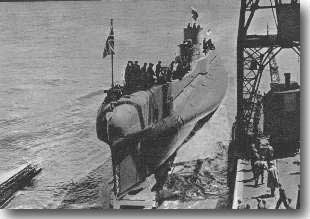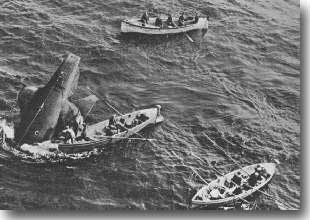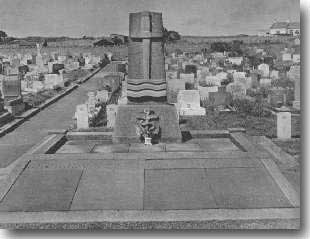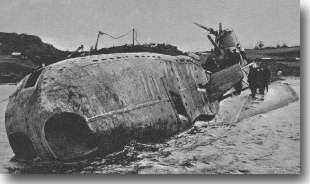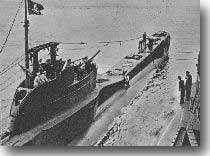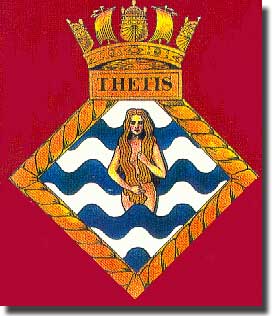|
The Tragedy of the British Submarine with two illfated names, Thetis and Thunderbolt
Introduction.
A submarine slides down the slipway at its launching A TRAGEDY WAS ABOUT TO UNFOLD. Thetis' diving trials. At 0940 ( 9.40 AM ) her Captain, headed his new command from Birkenhead out to Liverpool Bay, escorted by the Tug Grebecock, its additional duty, to remove the passengers from Thetis, prior to the dive, and transport them back to shore. But at 1330 ( 1.30 PM ) a signal indicated that all on board had decided to stay and witness the first dive. Indeed a fatal decision. At 1400 ( 2 PM ) air rushed out of the tanks with a WOOSH, and then for the next 50 minutes those aboard the tug watched as the submarine very, very, slowly dived below the surface, but it did appear to be " a very slow time dive." The bow of the submarine was at a slight angle, she seemed having trouble in diving, but finally at 1458 ( 2.58 PM ) she had disappeared. Trouble in diving. To further compound the problem, the layout of the bow door indicators was unusual, they were arranged vertically, 1, 2, 3, 4, 6, with 5 at the bottom. The shut position for the Bow Door of Number 5 tube was in a different position to that of all the other torpedo tubes, this led to the rear door of Number 5 tube being opened. ( all appeared to be in order, no water dripping out when the test cock was opened, and the bow door appeared to be closed ) Alas, not so, as a result of opening No 5 tube rear door, water flooded in from the open sea, causing the bow of Thetis, to plunge into the sea bed 160 feet below the surface. This left her stern stuck above the surface some 18 feet.
Thetis bow down, stuck in the mud of Liverpool Bay It was now dark, and the attending tug had drifted about four miles away from the dive site. Thetis was now on her own for a long and lonely night. Thetis found an increased level of carbon dioxide in the boat. At 0745 ( 7.45 AM ) the next morning, the sunken submarine was found by a searching aircraft, and surface craft rushed to the scene, it was now 18 hours since she went down. A destroyer, HMS Brazen arrived, to hammer on the hull to indicate help was at hand. The level of carbon dioxide in the boat was at a critical level, in all, but four trapped men escaped, Oram,Woods, Arnold and Shaw, the poisionous atmosphere putting the remainder to sleep before the 99 men on board died. Memorial Service. Thetis at the bottom of Liverpool Bay.
The crew of Thetis were in the main, buried here at Holyhead, Back to the surface 12 weeks after Thetis sank. On the 10th. of September, Thetis made it to Moelfre , but again shocking weather again intervened, and it was 68 days before all the bodies of the dead crew could be recovered, for a mass burial at Holyhead. Note, in our story about the "Golden Shipwreck Steam Clipper Royal Charter Comes To Grief." that tragedy also took place at Moelfre, but back in 1859.
Thetis beached after recovery Thetis returns to her birth place. All traces of her old identity were removed, and on the 26th. of October 1940 she commissioned as HM Submarine Thunderbolt, her new Captain, Lieutenant Cecil Crouch, R.N. The new crew were all volunteers, but they all were well aware they sailed in the old Thetis.
The old Thetis, rebuilt, and sailing as Thunderbolt. The Thetis Clip. Success as Thunderbolt. Sixth patrol in the Mediterranean. At 0854 ( 8.54 AM ) on the morning of the 14th. the sloop still had Thunderbolt pinned down and dived, Augusto knew she would soon have to surface, and his sound equipment told him he was immediately on top of the enemy submarine. Then, only a few yards away on his starboard bow, a periscope appeared. 24 depth charges were soon sent on their way, the British boat rose from the depths, briefly hung in the air, tipped to almost a vertical position. For the second time, this submarine's stern was thrust into the air, and then she plunged down, down, to a depth of 3,000 feet to the bottom of the Mediterranean. No one survived. It was exactly four years to the day that the four men, Oram, Woods, Arnold and Shaw had escaped from Thetis in Liverpool Bay. An Admiralty announcement. Conclusion.
The crest of Thetis |

